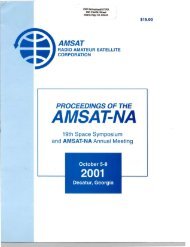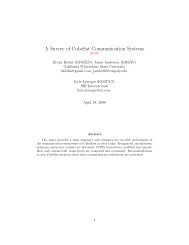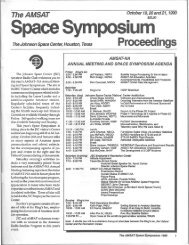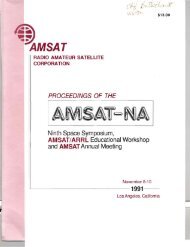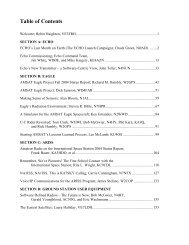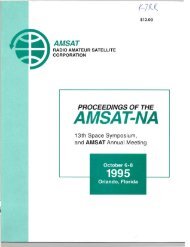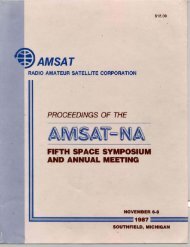October 27-29, 2000 - Klofas.com
October 27-29, 2000 - Klofas.com
October 27-29, 2000 - Klofas.com
Create successful ePaper yourself
Turn your PDF publications into a flip-book with our unique Google optimized e-Paper software.
Participants in CubeSat Program<br />
3.1 The Stensat Group<br />
3.1.1 Introduction<br />
The Stensat Team is a group of engineers including amateur radio operators who came together to design a satellite<br />
because we are engineers and have nothing better to do. We wanted an unusual hobby and figured this can't be too<br />
strange without the risk of being put in a mental institute. Kevin Doherty, Hank Heidt, Jim Bobbus, and Dave Nemai<br />
made up the original group for the first Stensat amateur satellite. Joining the CubeSat program is Ivan Galysh and<br />
Gil Dutchover from the Naval Research Laboratory. Each member brings a unique skill to the group and has the<br />
great desire to design and launch a successful satellite.<br />
We were asked to develop a standardized generic vehicle. The purpose is to design a bus once and allow users to<br />
concentrate on the payload and not the spacecraft design. The CubeSat design will provide a standard bus to allow<br />
simple and easy control of the payload while allowing flexibility in the design of the payload.<br />
3.1.2 CubeSat Design<br />
The basic design of the satellite is <strong>com</strong>prised of a cube structure with a stack of circuit boards inside. Each face of<br />
the satellite will be covered with solar cells. The center of the satellite will have two rechargeable batteries. The<br />
batteries split the functions of the satellite into two parts. One half of the satellite contains the satellite <strong>com</strong>puter,<br />
<strong>com</strong>munications electronics, and attitude control system. The other half is available for a payload.<br />
The CubeSat design is influenced by target characteristics defmed by the group and constraints placed by the<br />
CubeSat Program. The CubeS at program constraints are the dimensions and mass. The group defmes all other<br />
design characteristics.<br />
The CubeSat program put a couple of constraints on the design of the satellite. The first constraint was the<br />
dimensions to be a ten-centimeter cube. The cube also requires having rub rails for deployment out of the CubeSat<br />
launcher. The other requirement is the mass of the satellite. The current constraint is one kilogram. This constraint<br />
imposes significant limitations and challenges in designing the structure of the satellite. A 10-centimeter cube of<br />
water has a mass of one kilogram. Materials used in the satellite structure have a significantly higher specific density<br />
than water. This limitation requires a creative approach to designing the structure. A to-centimeter cube will have a<br />
large empty volume inside. The current CubeSat design has a mass of about 800 grams leaving 200 grams for the<br />
payload.<br />
There are several group defined target characteristics influencing the design of the CubeSat. The reproduction of the<br />
CubeSat is to be less than one thousand dollars. The design is to be simple and use standard <strong>com</strong>mercial<br />
<strong>com</strong>ponents. The critical <strong>com</strong>ponents selected should have some radiation data associated with it. For example,<br />
Motorola using the MOSAIC process manufactures the transmitter and receiver integrated circuits. This process is<br />
known to produce radiation tolerant devices.<br />
Another characteristic includes low power consumption. Available power is to be t watt. Bus mean power is<br />
specified to be about 250 milliwatts. Redundancy is designed into portions of the power system. Most of the<br />
redundancy lies in the solar cell circuitry and power distribution. Each face of the satellite contains eight solar cells.<br />
F our solar cells are connected in series. The two series of solar cells on each face are connected in paralleL If a solar<br />
cell fails on a face, only four solar cells are lost. The other four still contribute to the satellite power bus. Each face<br />
is connected in parallel. The batteries are also redundant. Circuitry isolates the batteries from each other while<br />
allowing them to contribute to the bus power.<br />
To minimize <strong>com</strong>ponents and structural mass, some <strong>com</strong>ponents have multiple purposes. The solar cells will<br />
provide power and also be used as sun sensors. The printed circuit boards with the solar cells also have a coil pattern<br />
on the opposite side for use as the magnetorquer coils. The circuit board stack containing the satellite processor,<br />
<strong>com</strong>munications, and payload will also be structural members.<br />
<strong>27</strong>




